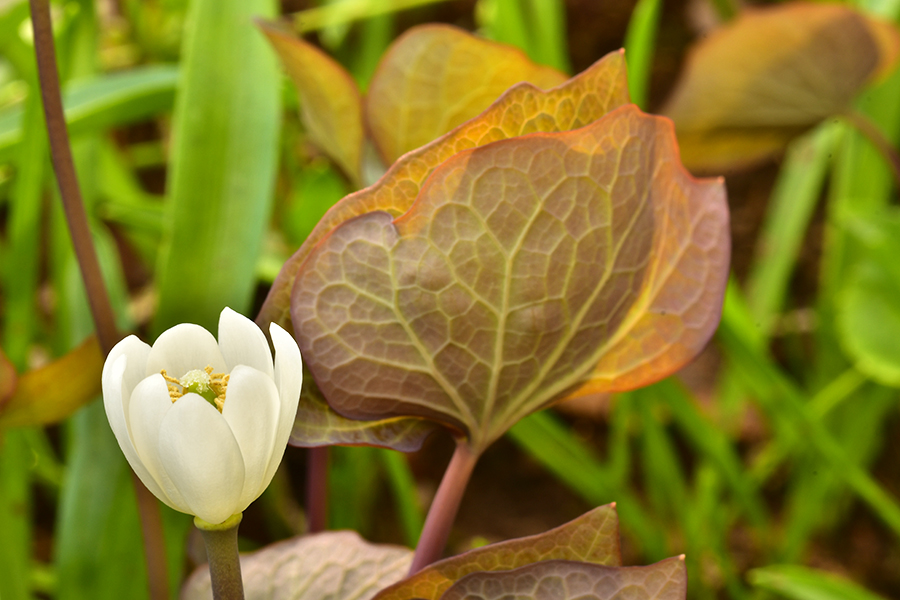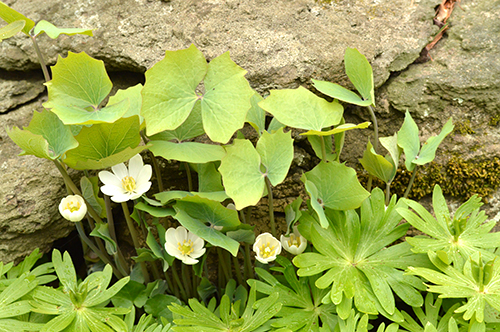
Botanical plant names often prove to be a stumbling block for gardeners. They are meant to impart descriptive details about a plant, yet understanding the Latin or Greek roots of the names can prove troublesome. To add to the confusion, in some instances the botanical name honors an individual who was important in horticulture. This can be equally as mystifying since many of these honored individuals lack widespread recognition. However, one plant that should instinctually draw recognition for the honoree is Jeffersonia diphylla, commonly called Twinleaf. The name pays tribute to Thomas Jefferson, the third president of the US and the principal author of the Declaration of Independence.
Jeffersonia diphylla, (Picture 1) is a member of the Berberidaceae or Barberry Family and is native to Eastern North America, ranging from Minnesota to Ontario, south to Alabama and Georgia. Despite its broad native range, it is relatively uncommon throughout. The genus contains only two species with its cousin, named Jeffersonia dubia, found in Korea and Eastern China, north into Siberia. Although the plants ultimately came to honor Thomas Jefferson, it is a rather storied tale of how the name came to be!
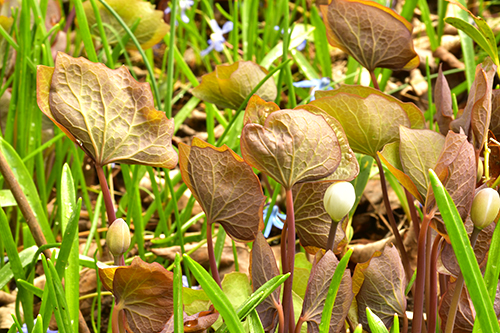
Jeffersonia diphylla was first collected by John Clayton (1694/5-1773), who for 53 years served as the Clerk for the County Court of Gloucester Virginia from 1720–1773! Clayton was also a prodigious collector of plants local to the region and he developed an impressive collection of nearly 700 specimens in his lifetime. He frequently sent specimens overseas to his friend and English naturalist Mark Catesby (1683–1749), who in turn shared them with other interested parties, including the Swedish botanist Carol Linnaeus (1707–1778). Included in these shared specimens was a dried sample of Twinleaf. Unfortunately, it was not collected while in bloom, making it far more difficult to assign to a genus. Partially based on where it was collected and perhaps from a suggestion by Clayton himself, Linnaeus described it as Podophyllum diphylla in 1753. Podophyllum is the genus for Mayapples and although it is also a member of the Barberry family, it proved to be the incorrect genus for this plant. Podophyllum was shortened by Linnaeus from the original name of Anapodophyllum, meaning 'Duck Foot Leaf', describing the leaf shape of most species. To Linnaeus's credit, the leaf of Twinleaf could be interpreted as a much-simplified duck-shaped Podophyllum leaf.
Fortunately, study of this plant was far from over. Andre Michaux (1746–1802) was a prodigious plant collector from France who explored and collected plants in Eastern North America from 1785–1796. Around July 3, 1789 he collected a living plant of Twinleaf complete with a seed pod in Smyth County Virginia, located in the Blue Ridge Mountains. After several weeks of travel, he gave the plant to his friend and well-known American botanist William Bartram (1739–1823) who planted it in his Philadelphia garden for study. One of the frequent visitors to Bartram's Garden was Dr. Benjamin Smith Barton (1766–1815), a professor of Botany at the University of Pennsylvania who had been searching for the elusive Twinleaf to study. Fortunately for the two botanists, they only had to wait two years for Michaux's plant to come into bloom during the spring of 1791. Together, the two studied and drew detailed images of the plant, flower and seed pod. They also came to the conclusion the plant was falsely placed in the genus Podophyllum. Barton was a friend of Thomas Jefferson as the two were both members of the American Philosophical Society. Founded by Benjamin Franklin in 1743, this Society promotes the sciences and humanities and is still in existence today. In May of 1792 during a weekly meeting of the Society, Barton suggested placing Twinleaf under a new genus he named Jeffersonia, honoring Jefferson's knowledge of natural history, botany and zoology.
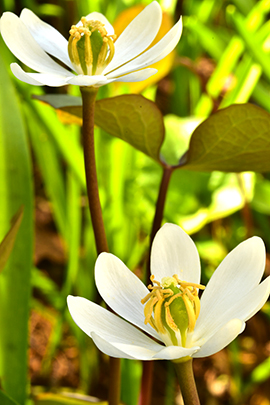
Barton also proposed changing the species to Jeffersonia binata. Binata refers to the leaves having two lobes, while Linnaeus described the foliage as being semi-cordate or heart shaped with double leaves or leaflets. In 1805, the German mycologist Christiaan Hendrik Persoon (1761–1836) argued that the species epithet of diphylla accurately described the species and, since it was the original name, it had precedence over Barton's suggested name. From this point forward, the plant was known as Jeffersonia diphylla.
Certainly, an interesting path and group of influential botanists leading to the final botanical name. To be certain, Jefferson could not have been honored with a nicer plant for the woodland garden! Both the flowers and foliage emerge individually from the fibrous root system, with the flower buds and unfurling foliage typically appearing together in early to mid-April. The foliage and flower stems initially have a reddish-purple coloration from anthocyanin pigments (as seen in Picture 2 and 3), which serve to protect the tender young tissues from UV light. The reddish foliage also acts as a very attractive backdrop to the opening flower buds. Initially, the unfurling foliage is visibly bolder and more apparent but, the flowers quickly stretch to 8" tall and take center stage. Each leafless flower stem or petiole bears one flower, as seen in Picture 3. The flowers are initially protected by 4 red blushed sepals, as seen surrounding a bud in Picture 2. These sepals fall to the ground as the flower bud swells, revealing 8 brilliant white petals. Each petal measures 1" long and when fully open, the cup-shaped flowers measure 1½–2" or in diameter. At the center of the flower lie 8 golden yellow anthers that tightly wrap around the central balloon-like ovary.
When the flower first opens, a tuft of translucent white stigmas appears atop the ovary and near the top of the opening flower, as seen in the closing image (Picture 7). Clearly, the stigmas are lying in-wait for pollinators who hopefully had just visited another flowering Twinleaf plant and have pollen to share. The flowers lack nectar, but reward pollinators with ample amounts of protein rich pollen. Flowers are pollinated by several bee species, as well as various flies and beetles in search of the edible pollen. If pollinators are lacking due to exceptionally cool April temperatures, the stamens continue to elongate and eventually bring the anthers into contact with the stigma. This allows for self-pollination as a last resort. Individual flowers bloom for 2–6 days with the flowers closing each night and the overall floral display of a plant lasting for only two weeks.
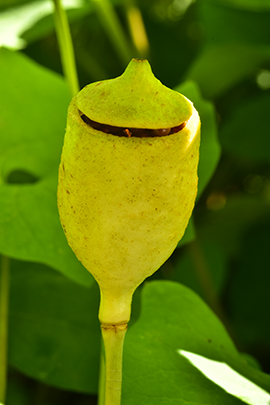
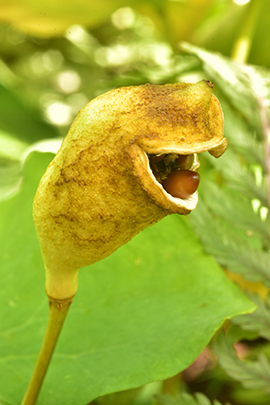
As attractive as the flowers appear in April, the seed capsules are as unique in releasing seed come June. After blooming, the peduncle or floral stem continues to grow, ensuring the capsule remains in view close to the top of the foliage. As it matures, the capsule assumes a shape very similar to that of a 'teapot', complete with a lid (as seen in Picture 4). A suture develops along a portion of the lid, which splits open at maturity and exposes a vessel full of light brown seeds! When the capsule initially splits open, I always think the structure appears as if it is smiling. When it opens more fully, as seen in Picture 5, it appears as if it is talking and even has lips! Once the lid is fully open, the peduncle proceeds to develop a crook or bend just under the seed capsule, allowing the contents to dump onto the ground. This may sound as a very inefficient strategy of seed dispersal for, why would a plant want seedlings immediately adjacent to the original plant? Seeds are supposed to be the 'legs' of the plant that move it to favorable new and unpopulated locations. The answer lies in the lipid rich appendage attached to the seed called an elaiosome. It is a food source for several species of ants, who carry the seed complete with the elaiosome back to the nest in order to feed the energy-rich appendage to their young. Once the elaiosome is eaten, the uninjured seed is discarded into an underground refuse bin where it is free to germinate the following year! In fact, the attraction for ants to the elaisomes is so robust, it is not unusual to see them roaming about the open seed capsules prior to the spilling of the seeds. The one challenge facing seed dispersal is rodent robbery! White-footed mice and other rodents will often help themselves to the teacup full of seeds before the ants have a chance to disperse the seeds. Although rodent robbery may sound harmful to the plant's survival, it also shows how the plant is instrumental in supporting the food web on several levels. It also demonstrates how the act of ants placing the seed in the underground refuse bins actually protects the seed from herbivory!
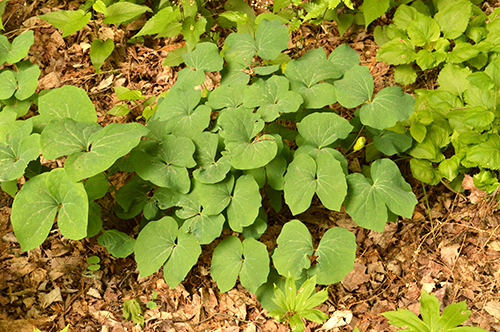
Arguably, there are plants that bloom longer, but few have such an interesting method of releasing seed or such unique and attractively shaped foliage! As previously mentioned, when the foliage initially appears and has yet to fully unravel, the exposed underside of the leaf displays a reddish-purple color. It also has a cordate or heart-like shape as Linnaeus had observed. The heart-like appearance is enhanced by the protruding network of veins ((as seen in Picture 2 and 7), which when combined with the red color truly gives the leaf an appearance of a person's heart! As the leaf matures the color transitions to blue-green and when fully unfurled the leaves are 12–15" tall and 3–5" across. Each leaf appears to consist of two leaves that are joined at the top of the petiole, prompting the common name of Twin Leaf. In actuality, it is one leaf that is tightly pinched in the middle where it is supported by the leaf petiole. I always find it magical how such a narrow point of attachment at the center of the leaf can physically support the weight of the two relatively large leaflets. Given a touch of imagination, the leaf bears a strong resemblance to a butterfly with its wings outstretched and adds a wonderfully exotic appearance throughout the summer (as seen in Picture 6). During years of ample rainfall plants quietly enter into dormancy during September, although they can enter dormancy earlier during dry years.
Twinleaf grows best in well-drained yet moist, loamy soils rich in humus and in the shade of tall trees. These were the exact conditions as described by Micheaux when he initially found the plants in Virginia. Hardy in zones 5–7, plants are tolerant of a pH range of 4.5–7, although they seem to prefer lightly acidic soils. Although the root system is mostly fibrous, it does produce short rhizomes allowing it to spread very slowly. However, where conditions are ideal and rodents scarce, the plant will gradually spread with numerous plants growing from seed. I have also found the plants to be remarkably long-lived, having grown a plant in loamy soils on a pond bank only 8–12" higher than the adjacent pond for over 30 years!
Jeffersonia is a botanical name with great name recognition that should not prove to be a stumbling block for most gardeners to understand. Despite the name recognition, the plant is as scarce in gardens as it is in nature. Having grown this plant since the 1980's, I can attest to its clump forming qualities and slow ability to develop seedlings thanks to its hungry 4-footed neighbors. However, I never found its inability to spread as a liability since the plant always provided a healthy clump of beautiful foliage, flowers and those captivating seed capsules, making it a wonderful 'Flowering Ode to Thomas Jefferson'.
